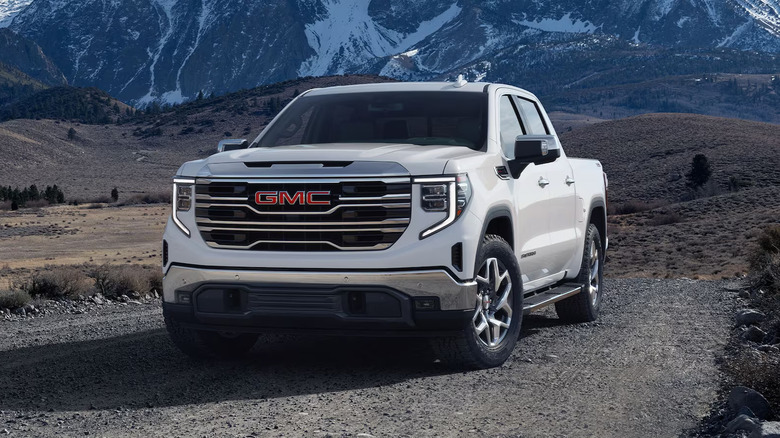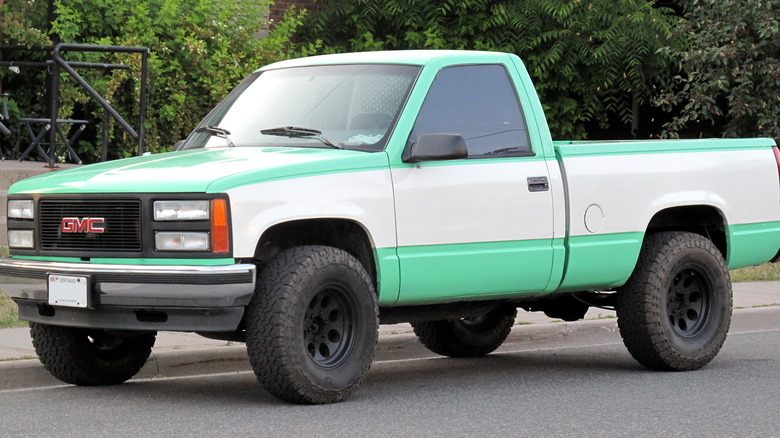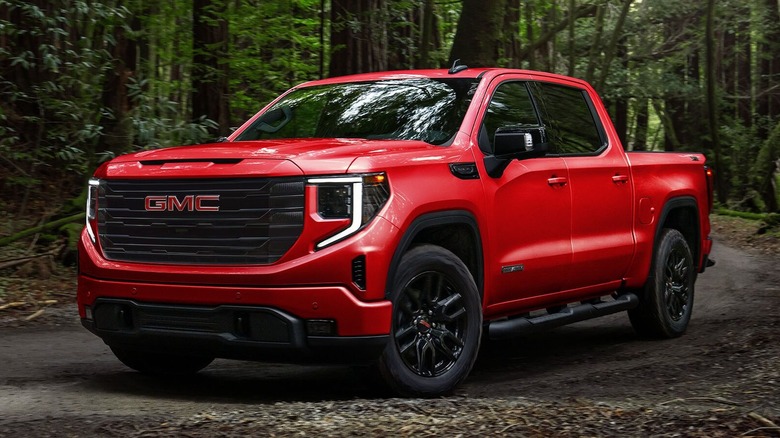Here's How The GMC Sierra 1500 Has Changed Over Each Generation
According to Car and Driver, the GMC Sierra is the eighth highest-selling car of 2023. The Sierra label has been around since 1986, when GMC abandoned the C/K model naming for their trucks in favor of the snappier Sierra name. Chevrolet followed suit with a name change for their C/K models, adopting the moniker Silverado for their iteration of what is an almost identical truck. The Silverado may be the better-selling truck of the two — placing at number two on the list for 2023 — but the Sierra has been a go-to option for many people over the years.
Since its creation 37 years ago, there have been five different generations of the Sierra 1500, the base model for the label. Like any vehicle, the full-size pickup truck has changed quite a bit as each generation makes its way to market. Some of these changes are obvious, particularly when it comes to the exteriors of these trucks. Still, plenty is going on inside them that continue to enhance their power and capabilities.
The first Sierra
The original GMC Sierra for the model year 1988 was a perfect baseline on which the company has been building for nearly four decades. The Sierra had a three-person bench seat with a standard truck bed in its basic form. Bucket seating wasn't introduced to the model until 1993, and only for extended cabs.
In terms of size, it was a full-size pickup, but today's sizes for these trucks would be relatively small. According to Car Gurus, the original 1988 model was about 194 inches long, 76 inches wide, and 70 inches tall with a 117.5-inch wheelbase. For comparison, Car and Driver calls the 2024 Ford Maverick the best compact pickup truck, which is nearly six inches longer and eight inches wider with a five-inch longer wheelbase. Under the hood, you had three different engine choices for the Sierra: a 4.3L V6, a 5.0 V8, or a 5.7L V8. That base-level V6 would get you 150 hp, less than half of what the base TurboMax engine gets in a 2024 Sierra 1500. For larger 1500 models back then, a 6.2L V8 Diesel engine was also offered.
In terms of variety, there were three decisions to be made: rear-wheel or four-wheel drive, standard or extended cab, and standard or long bed, the largest of which would bump you to 237 inches. This was a work truck and was built as such.
[Featured image by Elise240SX via Wikimedia Commons | Cropped and scaled | CC BY-SA 4.0]
Getting bigger with more variety
One thing is clear over the subsequent four generations of Sierra 1500s: GMC likes to go big. Each generation is slightly larger. In 1999, the standard length bumped from 194 inches to 203 to 205.6 inches. The most recent Sierra 1500 has grown to nearly 211 inches long, and this is before extended cabs or beds, which can make it as long as over 241 inches. That's nearly 50 inches longer than the original Sierra.
To match the increased size, you have increased power. The standard TurboMax engine gets you in the realm of 310 horsepower, and if that's not enough, a 5.3L EcoTec3 V8 boosts that to 355 horsepower.
The GMC Sierra 1500 has abandoned bench seating. This work truck has also embraced all the luxury options that have become commonplace in vehicles, from seat warmers to rear-view cameras. In terms of options, they go well beyond just the size and seating for your truck. You can outfit your Sierra with six trims: Pro, SLE, SLT, Elevation, AT4, and Denali. Each comes with different features, securities, and wheel sizes.
The original MSRP for the original GMC Sierra 1500, according to Car Gurus, was $10,495 ($28,367 adjusted for inflation). You won't find a 2024 model cheaper than $38,945 before additional features. What started as a rock-solid work truck is now far classier.


